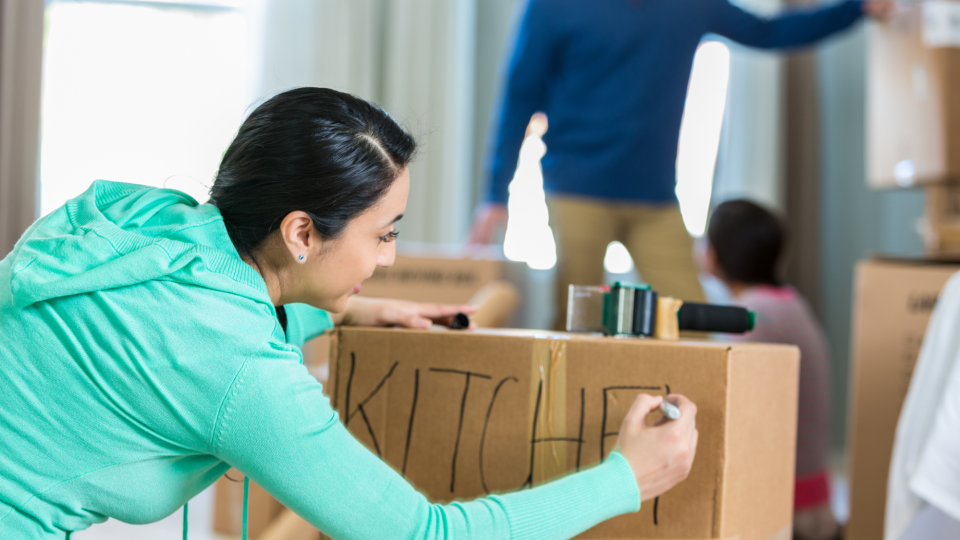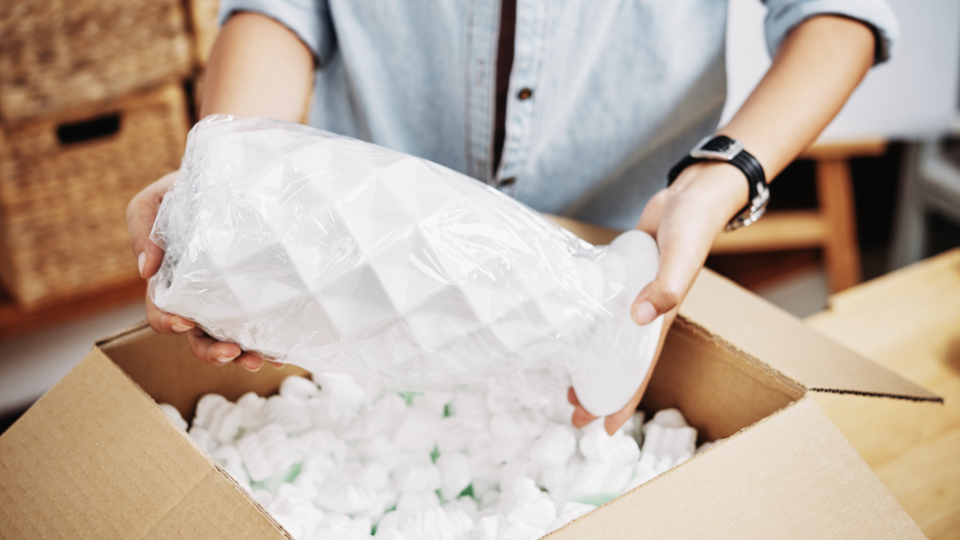How to pack for moving: A step-by-step and room-by-room guide
Content is created by CNN Underscored’s team of editors who work independently from the CNN newsroom. When you buy through links on our site, CNN and its syndication partners may earn a commission. Learn more

Few people love the packing process, but you can’t rush through it. We’ve compiled tips to help you prepare for your move and guide you through how to pack each room of your house so it doesn’t have to be so daunting.
5 steps to prepare for packing

You can make your move less overwhelming by breaking up your responsibilities into smaller, more manageable tasks.
Make a checklist
Having a checklist of tasks will give you something to cross off as you accomplish goals, and seeing the workload visibly will make it more manageable than when it exists solely in your head.
Keep this list handy, using an app on your phone if necessary, and be mindful of adding to it whenever something moving-related pops into your head. If you don’t keep it near you, you may be surprised how quickly you forget the task you just thought of. Use this list as a catchall; anything related to packing should be put on it.
Decide which items and rooms can be packed early and what you’ll need until the last minute, and then start chipping away at your checklist little by little.
Separate VIP documents and sentimental items
If you don’t already have your passport, birth certificate, social security card and other important documents sorted and stored in a fireproof safe, organizing these documents ahead of your move will reduce the chance that they’re lost or misplaced before you’re settled in your new home.
In addition, irreplaceable items, such as journals, photo albums and mementos, should be carried on your person during a move.
Organize your belongings
Decluttering is a vital part of getting organized. If you last used something six months ago or longer, consider donating it or keeping it in a storage unit until you’re ready to use it again.
We recommend packing non-essential belongings, such as books, artwork, hobby items, sports gear and seasonal decor, so you don’t have to go through them later. Keep like-items or items you intend to store in the same room and label them clearly.
Buy necessary packing supplies
You can purchase packing supplies from your chosen moving company or get savvy by seeking more sustainable avenues. Buy Nothing Groups are a great place to source bubble wrap, styrofoam and packing supplies from neighbors who have recently moved. You can also contact liquor and big box stores to collect their shipping boxes and packing materials before they break them down.
We recommend purchasing high-quality tape and markers to pack and label your boxes securely.
Choose the right boxes
Make sure to have boxes in various sizes, whether you buy or scavenge free moving boxes. Shawn Hill, the vice president of growth for MoveBuddha and seasoned mover with more than 51 relocations under his belt, knew about his move far in advance. He saved boxes from Amazon shipments for one year because he knew they were sturdy and came in all sizes.
Set up a packing station
Professional shipping companies have assembly lines to streamline the packing process. You can borrow this idea to make your packing process more efficient. A designated setup for packing your items will help keep your home more organized and incentivize you to work.
Clear off your dining room table or set up a workstation in a convenient spot in your home.
Lay out all your materials:
Boxes
Bubble wrap
Labels
Packing tape
Packing paper or peanuts
Plastic wrap
Scissors
Markers
Towels or blankets to protect delicate items
Also, consider setting aside the same hour daily to make it a sustainable and repeatable habit.
Check each room twice
Hill recommended that movers double-check each room before heading to their new home. He cautions you to check “the attic that has all the Christmas decorations” to make sure you’re not leaving anything behind.
How to pack for moving by room

Every room in your home has different needs because the contents differ significantly. Here are some quick tips for packing your bedrooms, kitchen, bathrooms and other living spaces.
Bathrooms
Bathrooms often have a lot of small daily-use items. Consider the following when packing your bathrooms:
Pack spillable items in plastic bags: Prevent spills by putting liquids in plastic bags or sealing them in bubble wrap.
Make a first-aid kit: Minor injuries, scrapes and paper cuts are common during a move. Keep a first-aid kit of go-to products so you can pack the rest of your medicine cabinet.
Use towels: You can line boxes with towels to prevent spills and cushion fragile items.
Wait for essentials: Prescriptions, deodorant and dental hygiene products are necessary for daily use. Pack them in a backpack or toiletry kit you can easily stow away on moving day.
Bedrooms
Bedrooms often have large furniture sets, sentimental items and a lot of clothing. Here are some tips:
Declutter clothes: Consider organizing a Purple Heart or Greendrop donation, hosting a yard sale, or passing on gently used clothing to a loved one. This step can be especially important if you’re moving to an area with a different climate.
Purchase wardrobe boxes and vacuum storage bags: For items stored on hangers, you can quickly transfer them to a wardrobe box outfitted with a convenient bar. Vacuum-sealed clothing bags can reduce the total volume of your belongings and save space in your moving truck or car.
Don’t unpack drawers: You can take the drawers out of your dressers, but keep your clothing in them. Secure the items inside by wrapping the drawers in plastic wrap and neatly stacking them.
Protect your mattress: Put a fitted sheet or mattress protector over your bed to prevent getting wet or damaged in transit.
Kitchens
Kitchens present unique packing challenges because they have many fragile items and things you’ll use until the last minute.
Use your linens to wrap knives: You can save on packing supplies and minimize the risk of injury on sharp kitchen objects by repurposing your cloth napkins, dish towels and table linens to pack your knives.
Put heavy things in suitcases: Rolling suitcases reduce the burden on your back, so they’re an excellent place to pack cast iron pans and other heavy items.
Add fragile labels: Remember to mark boxes containing dishes, glassware and other delicate items, so you know to handle those boxes carefully.
Use bubble wrap and recycled newspaper: Pack dishes, serving trays and other fragile items in bubble wrap or recycled newspaper to prevent chips, cracks and scratches.
Use liquor store boxes: Stuff mugs and glassware with recycled newspaper to support them in boxes. Liquor store boxes often have partitions that keep glasses from colliding.
Buy padded boxes: Retailers sell specially designed reusable boxes that you can use to move and store china and other dishes.
“Don’t forget to check those cabinets above the refrigerator that nobody ever uses and the dishwasher with your wife’s favorite pot in it,” Hill added.
Living and dining rooms
Living and dining rooms have bulky furniture. Here are some tips for moving them safely:
Carefully pack entertainment equipment: It’s best to pack TVs, speakers, video game consoles and sound bars in their original packaging if you have it. If not, use ample foam, bubble wrap and plastic before putting these items in boxes individually.
Remove lightbulbs: Lightbulbs are delicate; the last thing you want is shattered glass during the moving process. Donate them or store them safely in lightbulb boxes.
Use moving blankets: You can purchase or rent moving blankets to drape over furniture so boxes and loose items don’t damage the finish.
Deconstruct large furniture: Disassembling modular couches and removing the legs from dining room tables can make it easier to load the moving truck and squeeze through tight doorways.
Offices and home gyms
Offices and home gyms are often multi-purpose spaces. Conquer these spaces with ease when you follow these tips:
Take photos of your setup: Document your cord management by taking pictures to eliminate confusion when you set up your desk in your new home.
Inventory bulk items: Because heavy equipment and furniture aren’t packed in boxes, it’s easier to misplace them. Maintaining an inventory can help you keep track of them.
Consult the manual: Follow manufacturers’ instructions for disassembling exercise equipment so you don’t void warranties or damage the mechanics.
Pack books lightly: Boxes of books are unwieldy. Periodically lift the box as you pack it to ensure you can still easily carry it. Use smaller boxes, fill lighter than you need and don’t be afraid to use more boxes than anticipated.
4 tips for packing fragile items

Not all items require the same amount of attention when moving; things like dishes or art will demand consideration that a box of sweaters won’t. Having a few guidelines for these more delicate items can be particularly helpful.
Fill boxes strategically
For non-fragile items, fill the box to the brim to avoid it collapsing when stacking other boxes.
For fragile items:
Consider getting box dividers for items like glass cups to prevent them from crashing into each other during transit.
Eily Cummings, the vice president of corporate communications for moving and logistics company Unigroup, recommends that you place heavier items on the bottom when transporting fragile items.
Fill empty spaces with items that can double as cushioning, such as a wrapped t-shirt, a towel or a blanket.
Use smaller boxes for a snug fit
When boxing up more delicate items, a smaller box will not only be easier to handle but also limit space for the items to rattle around inside. A snug fit will encourage delicate items to stay in place and not crash against the box’s walls or each other in transit.
Layer the bottom and sides of the box for extra cushion
“Remember, when you are packing breakable items, you must start with a sturdy box, and you will want to line the bottom of your boxes with crumpled packing paper,” Cummings told us.
Wrap items thoroughly
Taking your time and being diligent is much wiser than haphazardly packing delicate items and paying the price later. To get the most out of wrapping:
Wrap things individually. It may take longer, but it will be worth it when you don’t have to buy new dishes after your move.
Don’t just wrap the bulkiest part of an item; Cummings recommended also wrapping things like handles on pitchers or vases.
Using the example of a plate for wrapping one by one, Cummings recommended that you “Wrap plates individually in clean packing paper. Using several sheets, start from the corner and wrap the paper diagonally across the dish. Continually tuck in the overlapping edges.”
Clearly label fragile items
Letting the movers or whoever is handling your boxes know that something is fragile inside will help prevent damage to the items. In addition to labeling the boxes, Cummings advocates for “draw[ing] an arrow to indicate which side of the box should face up.” These quick extra steps can make all the difference for longevity.
Bottom line
If you consider moving fun, you’re likely in the minority. For the rest of us, it helps to have an easy-to-follow plan and a manageable timeline to pack each room properly. Whether you’re moving from a small studio apartment or a multi-bedroom home with vehicles, pets and children, the process is the same.
You’ll want to protect electronics, declutter unnecessary belongings, pad and disassemble furniture, carefully wrap fragile dishes, strategically group books and set aside essentials until the last minute. If you follow those general tips, you’ll know how to pack for your move in no time.
— Additional reporting by Jack Byram
Frequently asked questions (FAQs)
Note: The prices above reflect the retailers' listed price at the time of publication.
For more CNN news and newsletters create an account at CNN.com

